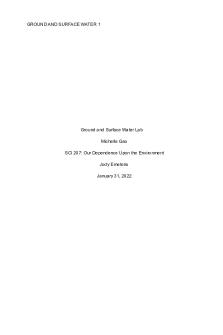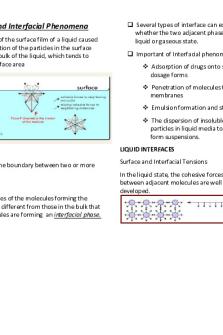Week 3 lab ground water and surface PDF

| Title | Week 3 lab ground water and surface |
|---|---|
| Author | Amanda Martinez |
| Course | Healthcare Management (3 |
| Institution | The University of Arizona Global Campus |
| Pages | 10 |
| File Size | 502 KB |
| File Type | |
| Total Downloads | 19 |
| Total Views | 150 |
Summary
Download Week 3 lab ground water and surface PDF
Description
Groundwater and Surface water Interaction
1
Groundwater and Surface Water Interaction Paula Perkins SCI 207: Our Dependence Upon the Environment Prof. Williams October 22, 2018
Groundwater and Surface water Interaction
2
Groundwater and Surface Water interaction Introduction The topic of this lab is how contaminates enter water and the atmosphere/ surrounding environment or water cycle. It is important to know how humans and their actions pollute and contaminate the air and water in their environment whether it be day to day activities such as driving a car or accidental oil spills. If your car has a gas leak even in the driveway it can still make its way into the drain systems and therefore our water. Once contaminates are in the water they will affect both our groundwater and surface water in different ways, some which can cause sickness to people and landscapes, the inability for food or plants to grow, or even the inability for animals to survive in their natural habitats. The main purpose of this lab was to develop a better understanding of how ground and surface water act in our environment, especially if it has been contaminated. We learn about the connection between groundwater and surface water with landscapes such as streams. We learn how the contamination of ground and surface water through man made products can make cause it to become unsafe for use for humans, crops and even animals. By conducting these experiments, we get a firsthand look at the connection of the water and the koolaid packets acting as a visual for the contamination gives us a visual to better evaluate what areas are more effected and which have been filtered out more. I thought in the first activity the small well would obtain more water because it was the same amount of water with less “land” or sand to absorb the water, thus making it fill faster. In the second activity I thought that the koolaid would still enter the soil because if the water enters the soil and it contains contaminates, I thought the color would be more noticeable than it was
Groundwater and Surface water Interaction
3
but honestly it was hardly noticeable at all. In the third activity In the third activity I thought that the clay would act as a barrier, which it did but I did not anticipate that some of the water from activity two would still make its way so far over, plus a small amount of what I am guessing is overflow that went past the clay still made small hardly noticeable deposits into the water.
Materials and Methods We used the clay in two activities once to make a barrier between the reservoir and well area and another time to make a barrier in the sand after we flattened it to see if the contaminates would still get into the sand. Sand and gravel were both used in order to make the “landscapes” in a plastic container. Plastic cups were used to hold water to pour into the foam cup in which we had poked holes in the bottom so as to simulate rain. Permanente marker was used for labeling and koolaid was used in the 2nd and 3rd activity to act as a visual for contaminates. Aquarium tubing was used to have access to the water which was taped to the side and water extracted from the tubes using a 10ml syringe. Plastic tubes were used to make wells in the sand and gravel and straws were inserted after water was added to measure the amount of water initially, once drained using the pippets, and after a specific amount of time had elapsed. I used the scissors to cut the tubes and tubing and my phone was the camera and the stop watch, I also used the ruler to record my observations from the first activity.
Results Activity 1
Groundwater and Surface water Interaction
Activity 1
Activity 1
4
Groundwater and Surface water Interaction
Activity 1
Activity 1
Activity 2
5
Groundwater and Surface water Interaction
Activity 2
6
Groundwater and Surface water Interaction
Activity 3 Groundwater
7
Groundwater and Surface water Interaction
8
Activity 3 with Clay barrier
Discussion My hypothesis on the first and third activity seemed to be correct and so therefore I accept them. I think basic knowledge along with the reading helped me have a better concept of what to expect in these scenarios. That plus after conducting the first two and seeing the flaw in my second I was able to curve previous notions I had. I still don’t know if I did activity two properly. I want to reject it because I feel the results would be different say had I used the whole packet. But with the amount and the fact that the soil does still act like a filter I have to accept the results as they currently stand. I learned the difference between groundwater and surface, water, I always thought they were basically the same and found it interesting that even if surface water near by is
Groundwater and Surface water Interaction
9
contaminated, ground water not to far away might still be safe or at least contain far lower levels of the contamination. I learned that not only batteries but printer ink, chemicals and even electronics are a serious link to surface water contamination when not properly disposed of. I also learned that just because water is in the ground doesn’t make it safe. “Some substances found naturally in rocks or soils, such as iron, manganese, arsenic, chlorides, fluorides, sulfates, or radionuclides, can become dissolved in ground water.” (EPA, 2015) I thought it was interesting how quickly the water refilled in the first activity but then steadied itself after an elapsed amount of time. I also learned that My kids kept bumping me and trying to get into what I was doing. I can not blame them for being interested but it makes it difficult that they are to young to be left alone and I am currently alone with them. 100% of the time. Another issue was the directions in activity 3. I really don’t think they were as clear as they could have been or that more step by step pictures or videos could have been utilized. By not having a classroom environment it makes things hard because If I suddenly find myself confused I cannot just stop mid experiment and wait for my teacher’s response, if she doesn’t respond till the next day the water would be absorbed and compromise the results and lab test all together. Scientists could use the information to find out where they might put wells and avoid contaminated areas. Once created scientists will need to monitor the area to make sure nothing contaminates the area on the surface as it could affect the ground water “In areas surrounding pumping wells, the potential for contamination increases because water from the zone of contribution, a land area larger than the original recharge area, is drawn into the well and the surrounding aquifer.” (EPA, 2018) The United States Geological Survey Scientists work with the Department of the Interior using a network of wells thought the US to monitor things like
Groundwater and Surface water Interaction
10
droughts and climate change and consists of approximately 200 wells. In Kansas the water levels are currently high, the USGS website allows you to research your own state, my state like many can be viewed in real time. The USGS monitors this for many reasons such as drought, the reason this is significant to scientists is,”1) Groundwater may be an alternative or supplemental source of water during periods of surface-water drought, if sufficient groundwater resources exist. 2) Reduced groundwater levels due to drought or increased pumping during drought can result in decreased water levels and flows in lakes, streams, and other water bodies. (On average, greater than 50 percent of stream flow is contributed by groundwater. Groundwater also is a major source of water to lakes and wetlands. Source: Circular 1139, p. 12) 3) Changes in groundwater/surface-water exchange can result in changes in water quality. 4) Decreased groundwater flow to surface waters can affect aquatic ecosystems that rely on a continuous supply of groundwater to sustain aquatic habitats and stream flow. 5) Reduced heads in aquifers can result in land subsidence. (USGS, 2016) References
Environmental Protection Agency (2015) Ground Water Contamination, EPA. [External Link] Retrieved From: https://www.epa.gov/sites/production/files/2015-08/documents/mgwcgwc1.pdf
United States Geological Survey (2016, December 28) Groundwater and Drought, USGS. [External Link] Retrieved From: https://water.usgs.gov/ogw/drought/ United States Geological Survey (2016, December 14) Climate Response Network, USGS [External Link] Retrieved From: https://groundwaterwatch.usgs.gov/net/ogwnetwork.asp? ncd=crn...
Similar Free PDFs

Week 3 lab ground water and surface
- 10 Pages

Ground and Surface Water Lab
- 8 Pages

WEEK 3 LAB - lab
- 2 Pages

Surface Topography Lab
- 11 Pages

Chapter 3 Water and Life
- 4 Pages

Properties of Water Lab
- 8 Pages

Water Balance Lab report
- 14 Pages

corrosion and surface chemistry
- 615 Pages

Surface and Interfacial Phenomena
- 16 Pages
Popular Institutions
- Tinajero National High School - Annex
- Politeknik Caltex Riau
- Yokohama City University
- SGT University
- University of Al-Qadisiyah
- Divine Word College of Vigan
- Techniek College Rotterdam
- Universidade de Santiago
- Universiti Teknologi MARA Cawangan Johor Kampus Pasir Gudang
- Poltekkes Kemenkes Yogyakarta
- Baguio City National High School
- Colegio san marcos
- preparatoria uno
- Centro de Bachillerato Tecnológico Industrial y de Servicios No. 107
- Dalian Maritime University
- Quang Trung Secondary School
- Colegio Tecnológico en Informática
- Corporación Regional de Educación Superior
- Grupo CEDVA
- Dar Al Uloom University
- Centro de Estudios Preuniversitarios de la Universidad Nacional de Ingeniería
- 上智大学
- Aakash International School, Nuna Majara
- San Felipe Neri Catholic School
- Kang Chiao International School - New Taipei City
- Misamis Occidental National High School
- Institución Educativa Escuela Normal Juan Ladrilleros
- Kolehiyo ng Pantukan
- Batanes State College
- Instituto Continental
- Sekolah Menengah Kejuruan Kesehatan Kaltara (Tarakan)
- Colegio de La Inmaculada Concepcion - Cebu






